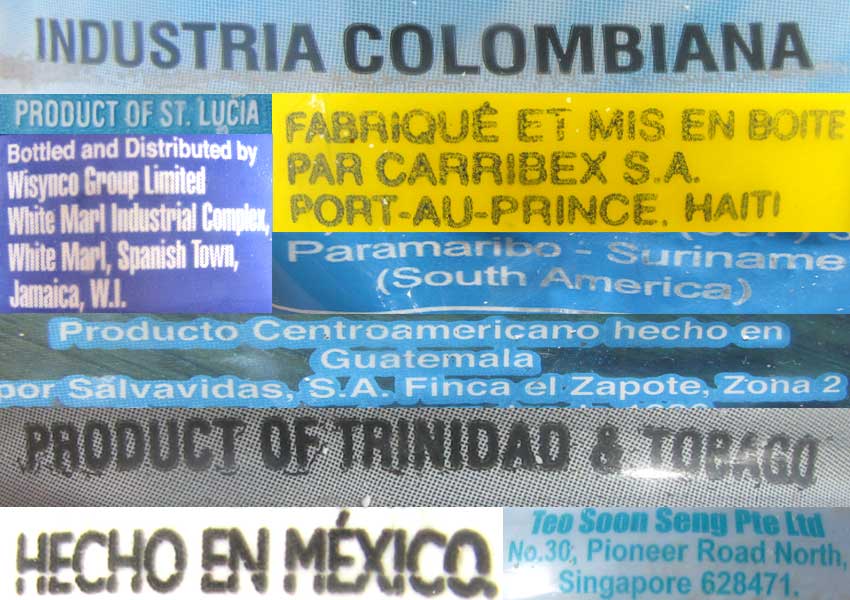Excerpts from Jim Conrad's
Naturalist Newsletter

from the August 14, 2011 Newsletter issued from Mayan Beach Garden Inn 20 kms north of Mahahual; Caribbean coastal beach and mangroves, ~N18.89°, ~W87.64°, Quintana Roo state, MÉXICO
COLOMBIAN BOTTLES & RIGHT SHOES
I've been reading Curtis Ebbesmeyer's Flotsametrics and the Floating World, which describes the author's career as an oceanographer studying the oceans' currents, especially with regard to what floats on it, flotsam. That got me to thinking more analytically about the mountains of garbage, mostly plastic, perpetually washing onto our beaches.
So, Friday morning I looked closely at the trash along the kilometer of beach between Mayan Beach Garden and what I call the Northern Point. Relatively few items bore labels revealing their country of origin, but enough did to provide a general feeling from where the trash comes from. That's a collage of snippets indicating the labels' countries of origin above.
The home countries of 33 items could be identified, and garbage from 15 countries was found. The nation providing most garbage was Colombia, with 9 pieces, or 27%. The next most represented country was Mexico itself, with 5 pieces, or 15%, and then Venezuela with four pieces, or 12%. Countries contributing 2 pieces, or 6%, were Jamaica, Trinidad and Tobago, Suriname and Honduras. The remaining countries sending only a single piece of trash each were St. Lucia, Haiti, Guatemala, Netherlands, Singapore, China, USA and Russia. I'm guessing that items from the last four countries were dumped from passing ships. Probably the item from the Netherlands entered waters of Dutch-speaking Suriname.
Clearly a one-way trash superhighway operates between here and northern South America. If you consider the island nation of Trinidad & Tobago as part of South America, then 17 pieces, or 52%, originated in South America.
That map also shows why I've never found trash from Cuba (stiff north-flowing current between Cuba and the Yucatán) and why there's never much from Panama, Costa Rica and Nicaragua (their Caribbean trash travels in circles).
On a separate issue, Ebbesmeyer -- who has beachcombed here at Mayan Beach Garden -- points out that right shoes and left shoes display such different sailing dynamics that during long floats right shoes may drift one way, left another, eventually causing certain beaches to specialize in catching one shoe type over the other. Here some of us have been pretty sure that on our beach right shoes predominate. On my short walk I noted the dispositions of 57 washed-up shoes and sandals. Of those, 31 were right (54%) while 26 were left (46%). That's not much of a statistical difference, but the exercise does remind us that sometimes we can start believing things for no good reasons.
Why is the color blue so dominant on these labels? It's because most were from plastic water bottles, and marketers know that people associate the color blue with cleanliness and purity.
Behold the irony of it.
from the March 8, 2015 Newsletter issued from Río Lagartos, on the Yucatan Peninsula's northern coast (~N21.60°, ~W88.16°), Yucatán state, MÉXICO
TRASH ON THE YUCATAN'S NORTHERN COAST
The above study was done on the Yucatan's eastern shore, on the Caribbean side. Now we're on the northern coast, facing the Gulf of Mexico, and you can see some of the mess on the Gulf of Mexico beach across from Río Lagartos below:

Is the abundant trash that washes ashore here on the northern coast facing the Gulf of Mexico similar to that found on the eastern shore facing the Caribbean?
When I began conducting the same study here, I cut it off after identifying the origin of only ten items, because they were all from Mexico. Ocean currents off the northern coast obviously are different from those on the eastern coast. On the eastern, Caribbean side, the Gulf Stream carries trash up from northern South America and Central America. Here on the northern coast, there's an offshore current generally flowing from east to west, but apparently that current doesn't branch off the big one carrying international trash northward off the Yucatan's eastern coast.
Not able to explain why all the trash I find on our northern beaches is Mexican, I wrote to Dr. Arthur Mariano at the University of Miami's Rosenstiel School of Marine & Atmospheric Science. He replied:
"I think it is because there is a wide shelf and the Yucatan Current has a large northerly flow component between the Yucatan and Cuba. It would take strong winds from the North to get the garbage onto the northern shores and those winds events, I think, are rare in that area."
So, normally we don't have strong winds from the northeast here, and they're needed to blow international garbage floating northward atop the Yucatan Current carrying things past the Yucatan's eastern coast toward Florida. What garbage that turns up here, then -- and there's plenty -- is all Mexican stuff, unless a strong wind from the northeast kicks up.